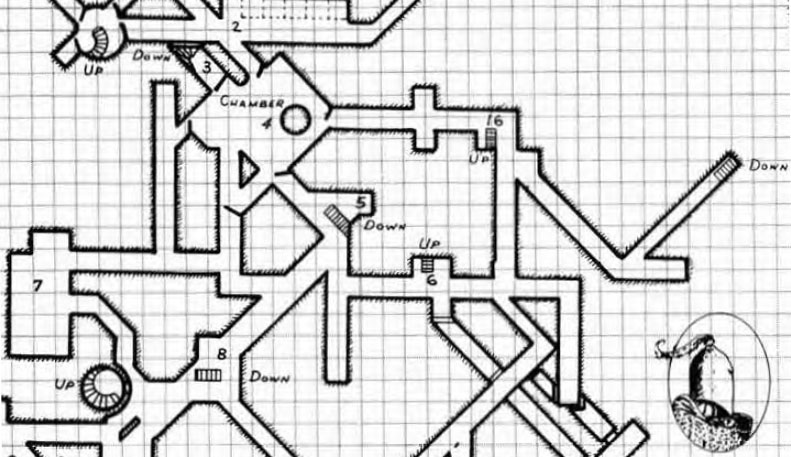
Newer readers may not be familiar with my old Reactions to OD&D series. If you haven’t read them, you may want to check them out first. It’s been more than half a decade since I last visited the series, but a recent discussion prompted me to track down and dust off some old notes.
Dave Arneson’s First Fantasy Campaign was published by Judges Guild in 1977. It “attempted to show the development and growth of his campaign as it was originally conceived.” (For those unfamiliar with the early history of D&D, the campaign in question is Blackmoor: The original dungeon, city, and wilderness setting in which Arneson created modern roleplaying games, and which would eventually become Dungeons & Dragons.) In practice, sadly, it is a deeply flawed book. It’s a haphazard concordance of lightly edited campaign notes, and Arneson, unfortunately, is not 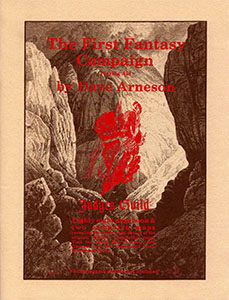 particularly effective in explaining what many of these notes mean or how they were supposed to be used in actual play. The confusing nature of the book is heightened because its contents span both the original Blackmoor material (starting in 1970), revisions made to his home campaign after D&D was published in 1974, and further revisions made to the material in order to run it at conventions from 1975-77… and Arneson is rarely clear about exactly which material is which.
particularly effective in explaining what many of these notes mean or how they were supposed to be used in actual play. The confusing nature of the book is heightened because its contents span both the original Blackmoor material (starting in 1970), revisions made to his home campaign after D&D was published in 1974, and further revisions made to the material in order to run it at conventions from 1975-77… and Arneson is rarely clear about exactly which material is which.
To take one small example, let’s consider the BLACKMOOR DUNGEONS section of the book. The material described here is literally Ground Zero for every single roleplaying game ever published (and, by extension, a huge percentage of pop culture, literature, and gaming over the past 50 years). Being able to get a glimpse into how Arneson actually ran those games would be an incredibly cool insight into a cultural watershed.
It’s frustrating, therefore, to discover that the First Fantasy Campaign makes it basically impossible to puzzle out what Arneson’s actual procedures were. I’ve spent an incredible amount of time pouring over this section of the book, and it remains a tantalizing enigma. I have, however, managed to work out a few details which I think others might find interesting.
Before we begin taking a close look at the text, however, it’s important to note a key point of context:
The Castle itself is still blank since it has been destroyed twice and rebuilt twice and then taken over by non-player Elves when the local adventurers were exiled. Thus, there are no sheets or goodies for it and only a sketch of its appearance. The Cavern sheet of Encounters is also lost (at least the first ones and the new one is in use). For these deletions I apologize.
The first six levels of encounters were prepared in the last two years for convention games, and set up along “Official” D&D lines. The last (7th – 9th and Tunnel Cavern System) are the originals used in our game. Additional crazy characters that got into the game over the years have been the Orcian Way and Sir Fang the Vampire.
(…)
Details on room, Cavern shapes for the Tunnel/Cave system have been lost or misplaced.
The first thing is that, as noted before, sections of Arneson’s notes as presented in the First Fantasy Campaign had been revised for convention play. This has, for better or worse, eradicated some amount of crucial information. The second is that the notes have also been partially (but not wholly) revised through actual play. And the third is that Arneson has deliberately not included some of his notes because he’s still using them in actual play. So you can already see that there are multiple layers of obfuscation here, made worse by the fact that some material has simply been lost due to the passage of time.
With that being said, let’s take a look at what Arneson is able to give us:
The other obstacle we almost immediately encounter here is poor proofreading.
For example, Arneson lists Group I, Group II, and Group III for monsters. Later he says: “The Grouping of the Monsters were Level I for 1st and 2nd levels; Level III Creatures for 3rd and 4th levels, etc . . .” It seems fairly certain that “Level III” here should be read as “Level II”. One might initially conclude, both due to similarity of usage and the use of the capitalized term “Grouping”, that “Group I” and “Level I” are meant to be the same thing, but they are clearly not. (Balrogs on the 1st level of the dungeon would be an unusual design choice.)
Level I most likely refers to something equivalent to OD&D’s Monster Level Tables, so Arneson is saying to use the “Level I” (sic) tables for the 1st and 2nd level maps of Blackmoor. But if “Level I” and “Group I” aren’t the same thing, what are the Group listings used for? Ultimately, after going over the text several times, I’m forced to conclude that there simply isn’t any explanation given for why he created the Groups or what purpose they served. (Perhaps the order of the Groups was inverted and they ARE the same thing as the Levels, with Balrogs being Group III creatures instead of Group I?)
THE ARNESONIAN DUNGEON
Here’s what I think can be worked out with a fair degree of certainty. If you want to run Blackmoor in a style similar to how Arneson originally ran it:
1. You’ll need Level I, Level II, Level III, Level IV, and Level V monster tables.
- 1st / 2nd level: Level I
- 3rd / 4th level: Level II
- 5th / 6th level: Level III
- 7th / 8th level: Level IV
- 9th / 10th level: Level V
These tables are not provided in the First Fantasy Campaign, but it’s likely that these were D10-based tables. (He writes “all dice throws were with 10-sided dice.” Although this appears as almost a non sequitur in the text, the only logical use of the D10s here would be on the monster tables.) To stock the tables, I would probably try to pull a full list of monsters appearing on the Blackmoor key and the anomalous “Group” listings and then distribute them appropriately. (You might also consider stocking all of the creatures found in Chainmail.)
2. You’ll need to pull the point values for creatures from Chainmail. (And “due to the addition of new Creatures beyond those given in Chainmail” create point values where necessary. Additional values might also be gleaned from other sections of the First Fantasy Campaign.)
3. There is a “magic protection point” encounter budget that is determined by the dungeon level:
- 1st level: 5 points
- 2nd level: 15 points
- 3rd level: 15 points
- 4th level: 25 points
- 5th level: 35 points
- 6th level: 40 points
- 7th level: 50 points
(It feels extremely likely that the value listed for either the 2nd or 3rd level is a typo. I’m guessing the values should either be 10 & 15 or 15 & 20.)
4. For each room, roll an encounter chance:
- 1st level: 1 in 6
- 2nd level: 2 in 6
- 3rd+ level: 3 in 6
5. If an encounter is rolled, roll 1d6 for a 1 in 6 chance that the room includes “a higher (stronger) creature”.
(By default, I would assume “stronger” just means “use the next Level monster table,” but you might have some chance of using encounters from even stronger Level tables. There’s also “a chance that weaker creatures would be present”, but it’s not spelled out. It’s possible Arneson just winged that. You might also consider rolling 1d6 and using a weaker encounter on 1 and a stronger encounter on 6.)
6. Roll on the appropriate Level table, then purchase creatures of that type using the “magic protection point” budget. If you don’t have enough points, then either “reroll or place a weaker version of the creature within the room (extremely old or young).
(Arneson gives no indication for mixed encounter types. You might wish to do so: Perhaps generate No. Appearing using OD&D methods and then, if you have points left over, check for additional encounters in the same room. OTOH, Arneson’s keys and wandering encounters give no indication that he ever used encounters with mixed creature types.)
CONCLUDING THOUGHTS
It remains unclear whether this was a “restocking” procedure that Arneson used between sessions or if he randomly determined results during play as rooms were being explored. It has the feel of a during-play system, but look at the key for the 7th to 10th levels (the ones set up according to the original schema and not revised for post-D&D convention play):
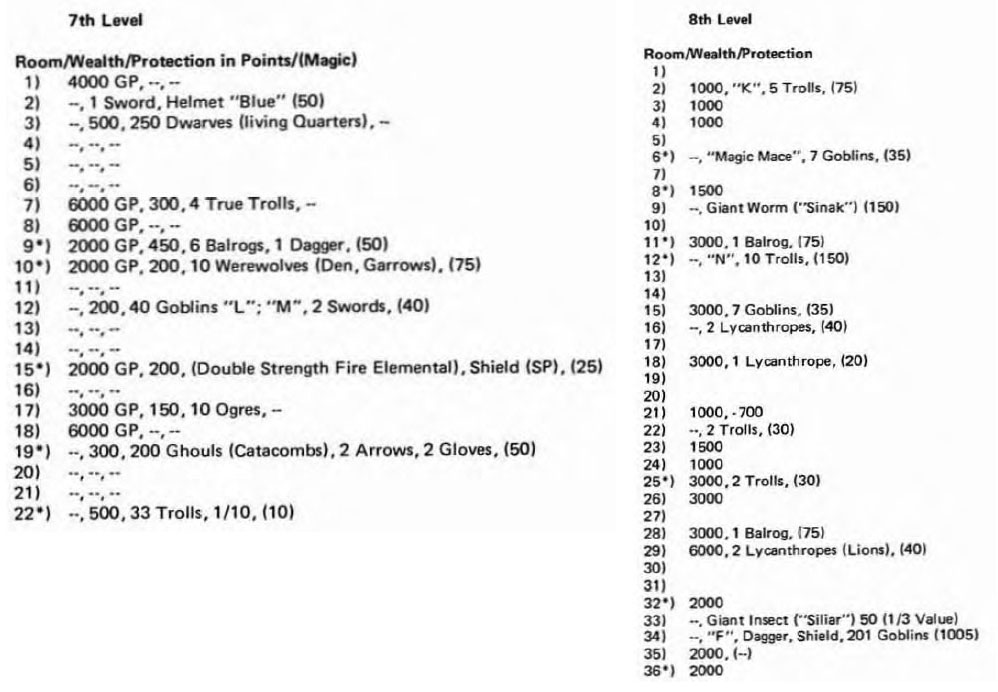
Note that the “Protection in Points” entry doesn’t consistently list points; it also lists specific creatures which have been generated with those points. If these are the notes Arneson was running the adventure from, then he was using the Protection Point system to restock. (For more on re-stocking dungeons, see (Re-)Running the Megadungeon.)
On the other hand, look at the similar key given for the Glendower Dungeons:
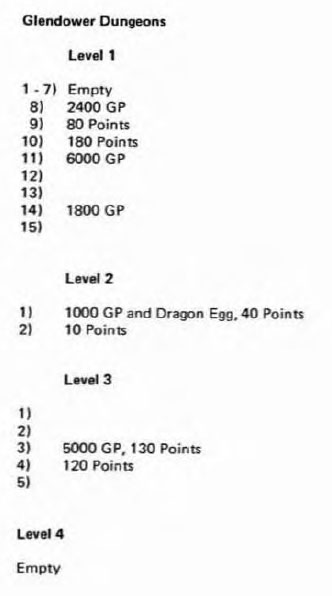 Those entries would appear to be the “Protection Point” or “Magic Point” values for those rooms, without the nature of that protection being predetermined. In the description of Loch Gloomen, Arneson also writes:
Those entries would appear to be the “Protection Point” or “Magic Point” values for those rooms, without the nature of that protection being predetermined. In the description of Loch Gloomen, Arneson also writes:
Defense of Area
30 – 180 Magic Points Creatures (two six-sided dice): 2) Giant; 3) True Trolls; 4) Roc; 5) Air Elemental; 6) Ogre; 7) Basilisk; 8) Goblins; 9) Ghouls; 10) Lycanthrope; 11) Balrog; 12) Dragon
The fairly clear intention here is to roll 3d6 x 10 to determine the number of Magic Points, and then roll 2d6 to determine the creature type.
So it seems quite likely that the Protection Point system was a flexible one. Arneson could:
- Stock the dungeon with specific creatures (using the Protection Point system as a procedural content generator).
- Quickly note “there should be X amount of protection in this room” (and then either specify it later or generate it during play).
- Randomly stock the dungeon room by room during play.
However, there are still several points which I find confusing. You might notice the “(Magic)” values given in the key for the 7th level of the Blackmoor dungeons, for example. It’s unclear what this entry is supposed to be: In any single entry it might be interpreted as an empty room’s encounter budget, the total cost of the listed “protectors”, or an unspent number of “magic protection points” that is meant to be spent in addition to the listed protectors. But no explanation seems to satisfactorily explain all instances (and any given explanation I’ve ventured is frequently contradicted by one of the usages). My suspicion is that he actually had a point system for determining how many magic items were located in each room (similar to the point budget for monsters in each room), but if so there’s no surviving evidence of how it would have worked.
Based on the key, it’s also likely that Arneson had some method for generating “Wealth” values independently from the Protection Points, but it’s not detailed here. (I’m guessing it was not dissimilar from that described in OD&D: 1 in 3 chance for treasure in occupied room; 1 in 6 chance in unoccupied room. And then rolls on some associated treasure table based on the dungeon level.)
It’s also unclear whether Arneson used wandering monster checks in addition to these room stocking procedures. It seems likely, but whatever method he may have used isn’t detailed. (Note that the poorly described “Wandering Monster Area” quadrant system described in the First Fantasy Campaign is part of the revision done to the material for convention play.)
Arneson also mentions that he would intermittently create “Home Bases for the Orc Tribes” and “special treasure troves”. These appear to have been completely arbitrary in their creation, but he would randomly roll to determine which level of the dungeon they would be added to. (“Thus the upper levels would occasionally have quite powerful encounters.”) The special distinction of the “Home Bases for the Orc Tribes” (as opposed to lairs for other creatures) seems significant, but I’ve been unable to tease it out. (And it may be entirely illusory.) There were four orc tribes in the campaign: Red Eye Orcs, Orcs of the White Hand, Isengarders, and Orcs of the Mountains, but the only information given relates to outdoor adventures, and it’s unclear what their agenda/function within the Blackmoor dungeon would have been.
I’ll also admit that I stopped trying to make sense of Arneson’s key for Blackmoor when I realized that he had 32 dwarves keyed to a room that’s 20′ x 10′. In the lower levels, there’s a point where he keys “250 Dwarves (living quarters)” into a room 10′ x 40′ long. There’s clearly some method to the madness here, but it’s beyond my ability to figure it out.

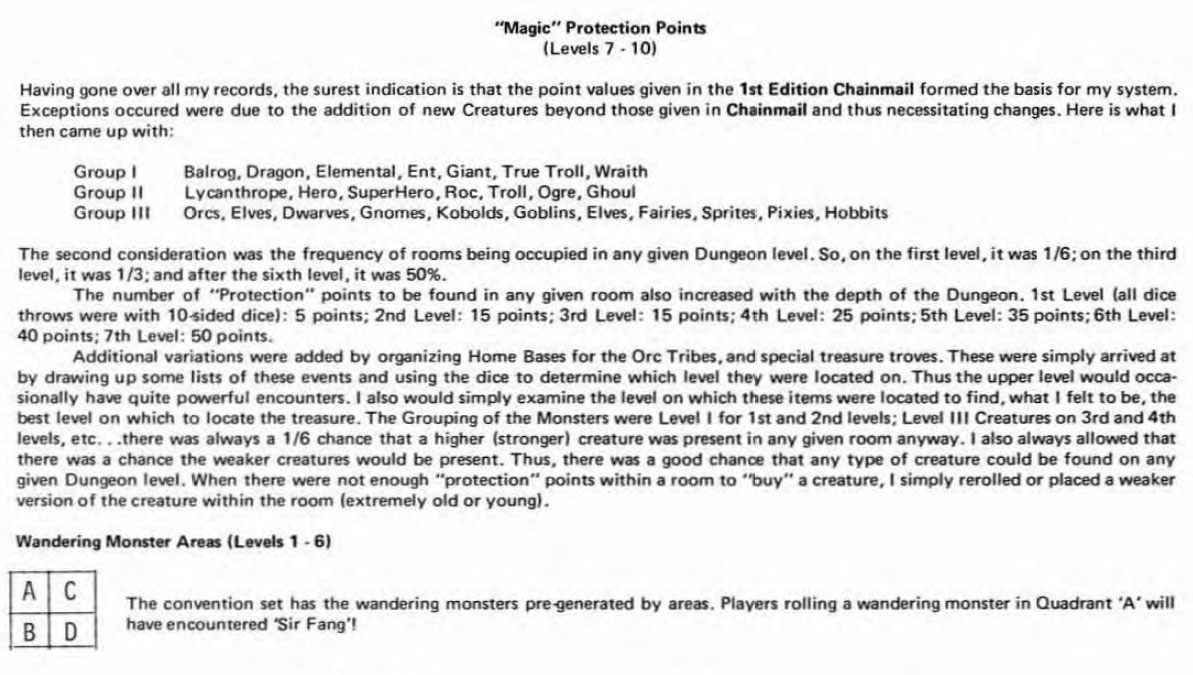












The 7th level key gives us an idea of how many “protection points” various creatures are worth: 250 Dwarves (Group III) are worth 500 points, so 2 each. 4 True Trolls (Group I) are worth 300, so 75 each; Balrogs (I) are likewise 75 points (6 Balrogs = 450 points). Werewolves (Lycanthropes, Group II) are 20 points at 200 for 10.
But then this fairly nice pattern breaks down a bit. 40 Goblins (Group III) for 200 points implies 5 points each. (Maybe the “L” and “M” notations have something to do with this; it could be these are Man-sized and Large goblins and hence a larger threat?) The double-strength fire elemental (Group I) at 200 points doesn’t quite seem to match the expected 75 points for a “normal-strength” fire elemental. Ten Ogres for 150 points implies 15 points each in Group II. And finally we have 200 Ghouls for 300 points (1.5 each, no respect) and 33 Trolls (Group II, not “True Trolls” as in I) for 500 points implies 15 points each.
So in general we have Group I creatures worth 75-100 points each (or more), Group II creatures at say 10-20 points each, and Group I creatures worth 1-5 points each. (I wonder if the “200 Ghouls” isn’t supposed to be “20 Ghouls” as that would make them 15 each and would fit the progression much better.) Anyway, we have the rudiments of a sort of challenge rating for different monsters, and then he’s assigning protection levels to different rooms. I agree with your interpretation that if a room wasn’t keyed specifically, he’d somehow generate a creature type and then assign enough of that creature to make up the required level of protection. And I agree that the “magic” section is pretty inconsistent. I also wonder about the asterisks marking some room numbers; is there info about that marking elsewhere in the text? At first I thought it was marking rooms with magical treasure, but if so it’s not consistent (see rooms 2 & 12).
Interesting, anyway. It’s fascinating to pore over these early examples of Actual Play.
I have to say I find something oddly charming about the “6 balrogs, 1 dagger” entry for room 9. I’m imagining something like the three sister-witches sharing one eye between them…
And most of these derived point values match those found in Chainmail (dwarves @ 2 point, balrogs @ 75, etc.), although there are variations. (Ghouls, for example, were 10 points.)
The “L” and “M” notations are, I believe, a reference to his Magic Swords Personality Matrix (which is found elsewhere in the FCC). “The Swords, indeed, comprise most of the early magical artifacts.”
No explanation is given for the asterisks.
I didn’t remember the point values in Chainmail; it’s been quite a while since I looked at that.
Do you have any idea what “Garrows” refers to? I can’t decide if it’s a typo/misspelling (and if so, for what), or a proper name, or some really obscure term that even Google comes up empty on, or what. Maybe I’ll name a new monster Garrows just to scratch that itch…
Probably meant “barrows”?
These make the OD&D books look like exemplars of organization and clarity!
These notes say more about the mind of Arneson and the style of play, then of the details of Blackmoor itself. It seems that he did not find it important to keep a set book of notes, and that he was more of an improvisatory DM.
It’s unfortunate that he is gone; it would have been nice to hear anecdotes about those first sessions.
Re: Garrow. Might be a typo for barrow. My theory is that it’s a misspelling / alternative spelling of “garou”.
“In the lower levels, there’s a point where he keys “250 Dwarves (living quarters)” into a room 10′ x 40′ long.”
This is totally explicable, actually; you just have to picture that it’s a really tall room and they all sleep in multi-story bunk beds! Or alcoves in the wall; I guess that works too.
I’m inclined to think that the “Magic” notation probably does refer to a magic item budget. In support of this hypothesis, I note that all of the rooms listing specific items have (Magic) numbers after them, and all but two of the rooms with (Magic) numbers also list specific items. I’m at a loss as to what “1/10” could indicate, though. And I’m also curious what a “Helmet ‘Blue'” is.
So, is there any explanation of the difference between Trolls and True Trolls?
In Chainmail, trolls are the same thing as ogres. True Trolls are the regenerating kind. (They aren’t explicitly mechanically modeled as such in Chainmail, but they’re taken from Anderson’s Three Hearts and Three Lions.)
“Blue” is another classification type for magic swords. (Arneson apparently ran out of letters and then started in on colors.) I don’t know why the word “Helmet” is inserted there. Might be a placement error in transcription from messy handwritten notes; might be a typo for some other word.
No idea when it comes to the “1/10” thing.
If “Blue” is a sword, my guess would be that there’s simply a missing comma between the two; that is, the magic treasure in Room #2 consists of a helmet and a sword.
Now you’ve got me wondering how he managed to come up with more than 26 distinct personality types for magic swords — and why he felt it necessary to list that information on the room key instead of simply rolling on a random personality table whenever the PCs acquired a magic sword.
Interesting read. Despite the frustration did it give you any new ideas for your own procedures or play style?
At this point, there was no radical new insight for me here. Perhaps the most notable thing is that this is a systematic method for RE-stocking (as opposed to stocking) a dungeon. The idea of restocking a dungeon isn’t a new one for me (I discussed it extensively in (Re-)Running the Megadungeon), but the methods I’ve used have been fairly simplistic procedural content generators. Arneson’s method is far more robust.
The other thing I find intriguing is the Glendower Dungeons key. By keying nothing but the point values, Arneson has basically created a tactical scenario that’s an open glass: Each time you run the scenario, the dungeons become something else as you feed those point values through the procedural content generators: An orcish stronghold. A balrog’s fief. A cult’s foul warren. A den of werewolves.
This makes sense when you consider Arneson’s miniature wargaming background: You develop battlefields, assign point values for building the armies, and then play out the scenario. You can reuse that battlefield and point values while ending up with acompletely different scenario depending on what armies are purchased with the point values.
I’m toying with the idea of trying to mock up a full set of Arnesonian generators and then running a group or two through the upper levels of Blackmoor, just to see what it feels like. (I’m debating how much interest I have in trying to incorporate other aspects of Arneson’s mechanics; but that seems to be a rabbit hole with no end, as Arneson’s pre-D&D rules were never truly preserved.)
What an interesting post! You’re going over what for me is quite familiar ground so it is great to see someone analyzing things with fresh eyes.
So the first thing to understand about Blackmoor dungeon as published in the FFC is that Levels 1-6 were randomly generated using the the methods on page 10 and 11 of OD&D vol 3 Underworld and Wilderness Adventure, for the monsters. Likewise the Treasures were randomly generatied using the Treasure Types tables found on pages 3, 4 and 22 of Vol 2 Monsters and Treasure.
So, aside from the map, Levels 1-6 aren’t really “Arnesonian” at all. They are (with one or two interesting exceptions) random out-of-the-book D&D.
However, levels 7-10 and the tunnels are all original Arneson.
Now, on stocking – that business with the groups I, II, III is indeed confusing. However you needn’t actually worry about it. Whatever exactly Arneson was talking about, it’s kinda moot. If you look carefully at levels 7-10 and Tunnels, you will readily see that the monsters don’t fit the group schema at all. In other words, if Arneson ever used the group schema he is talking about, there is no evidence of it in the surviving material in the FFC.
The same is true of the “magic protection point encounter budget” – the suggested means he gives to generate protection points per level. What he says in that intro and what he actually did in the dungeon is two (actually more than two) different things. The link below will explain more.
On protection points – you’ve basically got it, except for the greater and lesser mechanic which is a function of multiplication or division. To see how that works and basically learn everything else you ever wanted to know about Arneson’s prottection point method but were afraid to ask, have a look here: http://boggswood.blogspot.com/2014/08/point-buy-systems-for-stocking-dungeons.html
Another post of interest would be on Blackmoor dungeon’s number appearing:
http://boggswood.blogspot.com/2015/11/appearing-in-blackmoor-dungeon.html
and Arneson’s early take on the wandering monster:
Lastly, I would advise against bringing Loch Gloomin into the mix when trying to understand Blackmoor dungeon. Arneson like to change the way he did things. For a detailed breakdown of the Loch Gloomin stocking method, you can turn to this post:
http://boggswood.blogspot.com/2014/08/stocking-blackmoor-wilds-in-1972.html
There’s a ton of Blackmoor resources if you are interested.
Of course, I’ve got a whole lot more info on Blackmoor dungeon, aligning the maps, stocking, treasure etc. on my blog if you go back through, and we also talk a good bit about this stuff on Havards’ comeback inn forum here: http://blackmoor.mystara.net/forums/
Fun Times!
Here’s the link to Dan’s post on Arneson’s wandering monsters, for those interested:
http://boggswood.blogspot.com/2015/11/arnesons-wandering-monsters.html
Thanks Justin – yeah forgot that wandering monster link – glad you found it!
“Note that the “Protection in Points” entry doesn’t consistently list points”
I feel obliged to point out that this is incorrect. Besides the room number, the format is Wealth/Protection in Points/Magic, and this is consistently adhered to in the table. The wealth is always explicitly listed in GP; if there’s no wealth the first part is marked –. The second part is consistently listed as protection points followed by monster number and type, whenever there are monsters, e.g. 500 points/250 Dwarves, 300 makes 4 True Trolls, etcetera. Magic is the last entry and listed as items, then the point value in parentheses, e.g. 1 Sword and the Helmet “Blue” making up 50 points. Two swords are worth 40 points elsewhere in the table, so either the Blue Helmet is quite good, or else the point value is meant to indicate how good the items should be once generated fully.
My personal speculation would be that the “Blue” helmet is part of a set with the “Blue” sword and armor, which belonged to Blue Bill a.k.a. the Blue Rider, mentioned elsewhere in the FFC.
I purchased that Judges Guild product, FFC, on the same day that I bought “The City State of the Invincible Overlord” product, IIRC 1977 or 1078. To say that I was appalled at the poor quality of the FFC, having spent some of my meager cash on that item, is an understatement. (The City State package, on the other hand, got a lot of use, and was a great investment of my scarce spare money; I was in college at the time). If I still have it (I may have tossed it years ago, since is was so poor in quality) I’ll use this guide of yours to go over it again. Thanks, Alexandrian, for your efforts at bringing it back to life.
Regarding the 250 dwarves packed into a 10 x 40 foot room, I have a couple of times written into my own adventures that guards, soldiers, etc., are required to share beds which they sleep in, in shifts while the other guy is on duty. This to explain why there are more enemies running around for fighting than may be accounted-for, accommodations-wise. (The big bad is often a cruel tasmaster, after all.) However, this can generally only account for a doubling of the normal accompaniment, maybe a tripling if we’re talking Sauron levels. I don’t know that it can help explain things here, but I thought I’d just throw that out.
>>>Skarloc says:
“….Magic is the last entry and listed as items, then the point value in parentheses, e.g. 1 Sword and the Helmet “Blue” making up 50 points….”
That bit has tripped up more than one person, but it should be read as “sword and helmet – (blue)” In other words, it is the sword that is Blue, not the helmet.
For those who don’t know, Arneson created a list of magic swords written on 3×5 cards. The cards were in two groups depending on how powerful they were. The first group he labeled alphabetically, and the second he labeled by color. “Blue” was one of these swords (which was indeed owned by the Blue Rider). Another was “Maroon” owned by the Great Svenny.